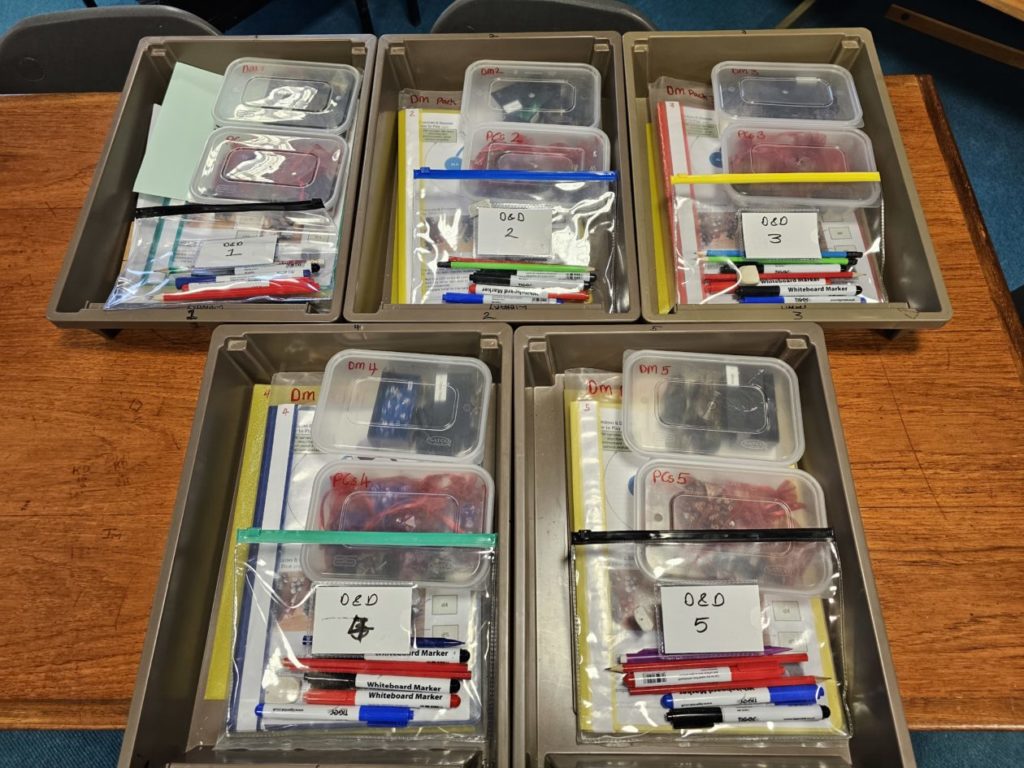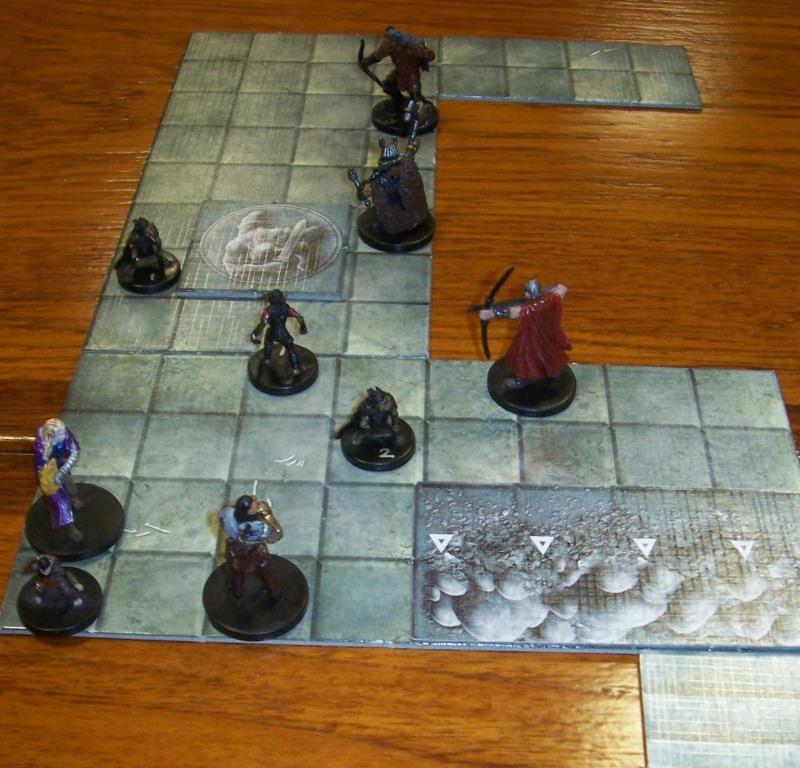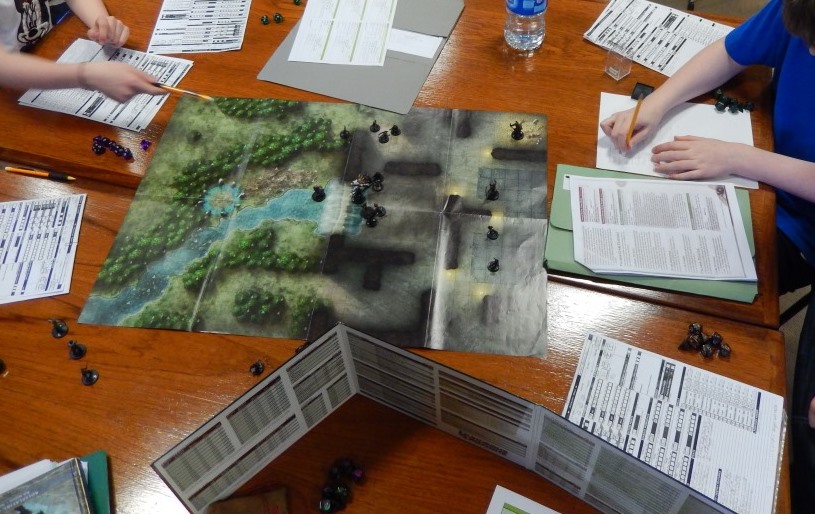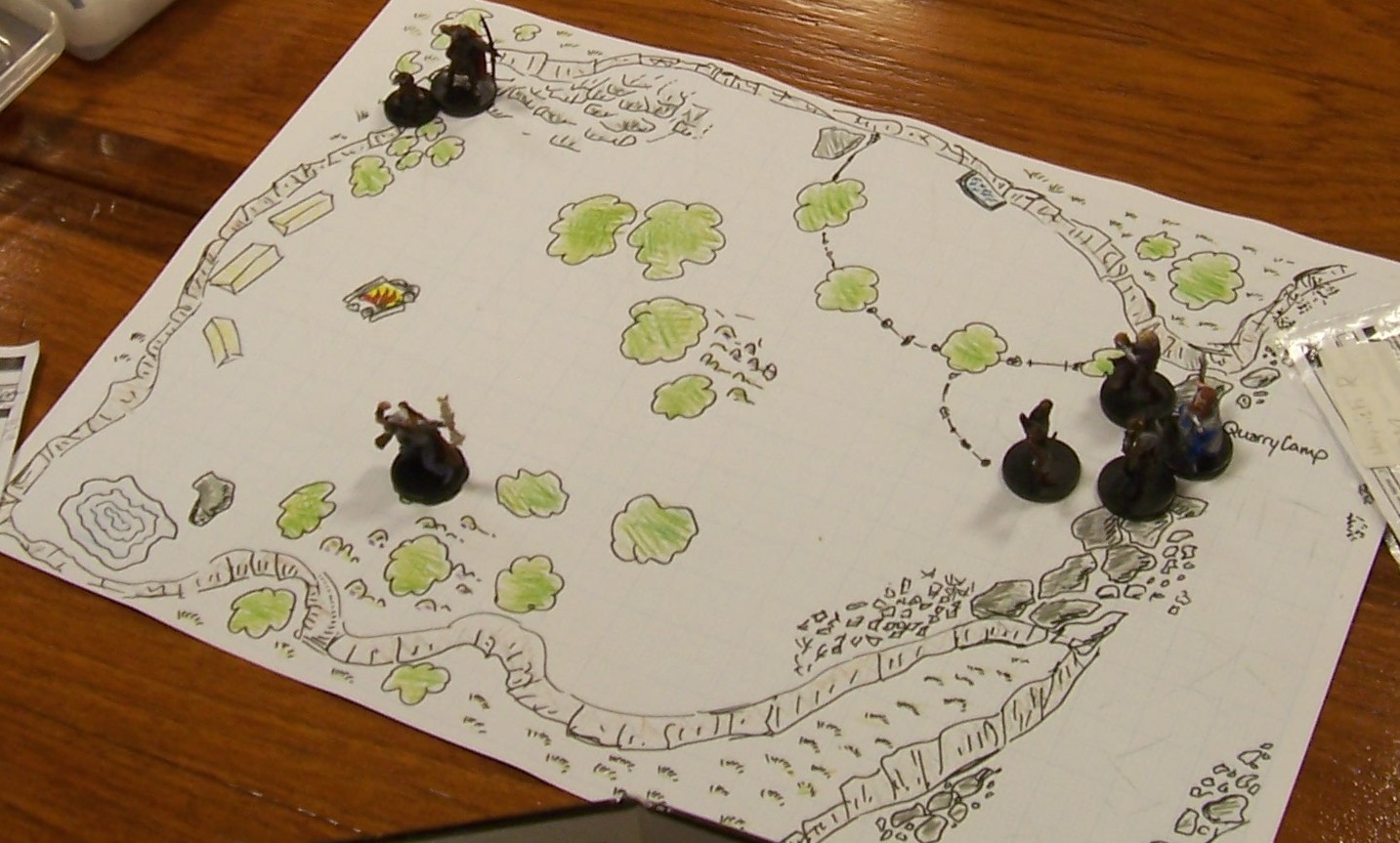1. Equipment:
- Essential – Several d20 sets of polyhedral dice (d20; d12; d10; d8; d6; d4); Pre-made adventures (if you don’t feel able to create your own) and character sheets*; Players Handbook; Monster Manual; Pencils and erasers.
- Desirable – Dungeon Master’s Guide; Miniatures** to repr
 esent characters and monsters, although coloured counters can be used – the Librarian painted old half pence pieces. Warhammer models are also useful for this; grid*** ; Chess pieces have also proved useful; DM screen (if you choose to keep your dice rolls secret).
esent characters and monsters, although coloured counters can be used – the Librarian painted old half pence pieces. Warhammer models are also useful for this; grid*** ; Chess pieces have also proved useful; DM screen (if you choose to keep your dice rolls secret).
For the DM
It is useful to have a tray or trays (if more than one group / DM) prepared with relevant equipment for easy access, especially if you only have a short time.
-
- Plastic folders for player characters in use and spare pre-made PCs
- Box for DM with some miniatures to represent monsters / NPCs
- Box for players with spare dice and miniatures to represent their characters
- Pencil case with pencils, eraser, and dry wipe markers for on-the-fly map drawing
- Clea plastic with a one inch grid printed on it (A4 is generally big enough – see below for templates) – we have larger wipeable battle mats if they are needed as well)
- A guide on how to play – including table rules
- Actions in combat reference cards

Character Sheets
Pupils can create their own characters, but it is often easier to use pre-generated characters (eg. the ones in the starter set) as it takes time to create one from scratch. In the library keen players come in at lunchtime and use the Creating a Dungeons & Dragons Character guide and Player’s Handbook.
The character sheets can appear quite complex to begin with. A useful tip would be to ensure that the main sections of the sheet are highlighted. To this end, one could colour each of the most used sections: Initiative; Saving Throws; Skills, and Attacks. This means that if a player is struggling to find what they need (which even happens with experienced players), then the DM can say “Attacks in purple box”, for instance.

As a learning experience, during the initial introduction to the game, one could ask the pupils to colour in each section themselves – using the colours you set out so all are the same. This allows them to develop familiarity from the outset. This might also be useful for those who have processing issues with number and text, and one should also ensure that pupils (dyslexia) who have been identified as needing coloured paper rather than white, should be given a character sheet on the relevant colour.
Grids
Use miniatures and a square grid or hex grid to help visualise the scene and show the positions of PCs and enemies. D&D doesn’t necessarily need these as players can just use their imagination to describe where they are – ‘theatre of the mind’.

1″ square / 1 hex = 5′ in the game world (2cm square graph paper works too). Wipe clean grids are handy, but a bit of A3 with a grid on it would be good enough. Some pre-made adventures come with printed map layouts or you can purchase pre-printed card tiles. Game world measurements use imperial measurements (USA product) so it is worth explaining this to your players.
Blank grids: A4grid (2.5cm) squares – print out on A4, use as is; A3grid – print out on A4, increase size to A3 using photocopier.
2. Groups: Best played in groups of 5-6. One Dungeon Master to lead the game and 4-5 players with their ‘player characters’ (PCs). Less than 4 PCs can make the game tougher as most published adventures are often geared towards this number however if you only have a short timescale this would be ideal. An experienced DM, though, would reduce the numbers of enemies to ensure there are not too many PC deaths. 😉 Experienced DMs may also be able to run larger groups, but having clear table rules, in particular, players should not talk over each other or the DM, be ready for their turn and importantly, listen.
3. Dungeon Master: The DM will run the game. S/he will provide the detail of the setting, play the creatures and NPCs (non-player characters), describe events, actions, places, landscapes, etc. A DM can:
- New to the game – buy the 5th edition starter set which gives a basic set of rules, 5 pre-made PCs and an adventure scenario – The Lost Mines of Phandelver. Read the Starter Set Rule Book (32 pages) first. It is also a good idea to read the adventure in whole prior to running the game. The Dungeons & Dragons Essentials Kit is also a great way of learning the game and introducing new players.
- Experienced DMs – create own adventures.
- Don’t have time to create own adventures – buy in pre-made adventures. Dungeon Master’s Guild or DrivethruRPG are a good place to head for adventures you can download some for free, ‘pay what you want’ (please pay something as it takes time for creators to produce their work – $1 /£0.80 is not a lot to ask) or set price. Resources on DMsGuild are produced by Wizards of the Coast (the publisher of D & D) and many fan produced works.
- You can also purchase the adventure module books published by Wizards of the Coast: eg. Hoard of the Dragon Queen; Out of the Abyss; Curse of Strahd, to name but a few.
4. Timing the Sessions: Ideally one would want to play D&D in sessions of 2-3 hours (more is brilliant). In a school with a set timetable we have to fit a session into a 50 minute lesson or even a 40 minute lunchtime (we are lucky to have timetabled activities on a Friday) or thereabouts. It can be difficult to maintain continuity with short sessions, but carefully managed one can do it. Pupils are often interested in the combat side of the game – the dice rolling, the miniatures on a battle grid – rather than pure roleplaying – so make that a bit more of a priority. Don’t spend an entire session having them travel between towns with little happening.
Tips for keeping on task in short sessions:
- Players – keep in the game. No off topic chatting. No mobile phones (texting, etc) unless using a D&D app for the game or for photographing miniature positions at the end of the game.
- In non-combat encounters, let players discuss their plans between them. Ensure all get a chance to have their say if necessary, but don’t let such discussion drag out.
- Turn order in combat = initiative – players must be prepared for their turn. If they aren’t ready or don’t make a decision on what they want to do, they lose their turn or drop down to the bottom of the initiative. For time saving, on can just go round the table in order.
- DM keep notes and encourage players to keep notes.
5. Types of Action: The D&D world is whatever you and your players want to make it.
Social Interaction: Non-combat: interaction with NPCs (non-player characters) – usually roleplay with a little dice rolling to determine outcomes.
Exploration: Travelling; resting & downtime; investigating / searching for clues; shopping; negotiating traps and obstacles.
Combat: the battles!
6. Table Rules: Have a set of table rules and stick to them.
7. Recommended Resources
- Basic Rules for Dungeons & Dragons – https://dnd.wizards.com/articles/features/basicrules
- DnDBeyond is an online toolset. Anyone over 13 can sign up to it and access the basic rules for free. Also allows character creation and downloading character sheets.
- Core Rule Books:
- Player’s Handbook. Wizards of the Coast. 2014
- Monster Manual. Wizards of the Coast. 2014
- Dungeon Master’s Guide. Wizards of the Coast. 2014
- The following come with basic rules and can be used without the need for the core books and are aimed at beginners. Useful if you are just starting out.
- Starter Set: The Lost Mine of Phandelver. Wizards of the Coast. 2014
- Essentials Kit: Dragon of Icespire Peak. Wizards of the Coast. 2019
- Starter Set: Dragons of Stormwreck Isle. Wizards of the Coast. 2022
Resources for RPGs can be expensive, however it is very worthwhile reaching out to the ttrpg community on social media – they can be very generous when it comes to RPGs in schools. As it can be seen from the donations page, we have received many resources this way for which we are very grateful.
8. Useful Links
- Detentions & Dragons Podcast (Running D&D in school) – https://detentionsanddragons.libsyn.com/
- EducationalDM – https://sites.google.com/view/educationaldm/home
- Leveling up Reluctant Readers with Dungeons & Dragons. International Literacy Association. (2022) – https://youtu.be/rGiVT4dIHNY
- Building Emotional Literacy through Dungeons & Dragons. International Literacy Association. (2022) – https://youtu.be/MgJwPavm7d0
- Using Dungeons & Dragons to Scaffold Writing Instruction. International Literacy Association. (2022) – https://youtu.be/_3hPBenqXb4
- TTRPG Kids – https://www.ttrpgkids.com/
9. Other Role Playing Games
- Critical Core (An RPG designed for use with those with ASD). Game to Grow (2022) – https://gametogrow.org/blog/
- Pathfinder Roleplaying Game (Fantasy RPG born out of 3rd edition D&D, now in its 2nd edition). (2022) – https://paizo.com/pathfinder
- Inspirisles (An RPG which teaches BSL (or ASL) as you play). Hatchlings Games. (2022) – www.hatchlingsgames.co.uk/inspirisles
- Vaesen (RPG set in the ‘Mythic North’ based around Scandinavian mythical creatures. There is also a Mythical Britain supplement.). (2020) – https://freeleaguepublishing.com/en/games/vaesen/






